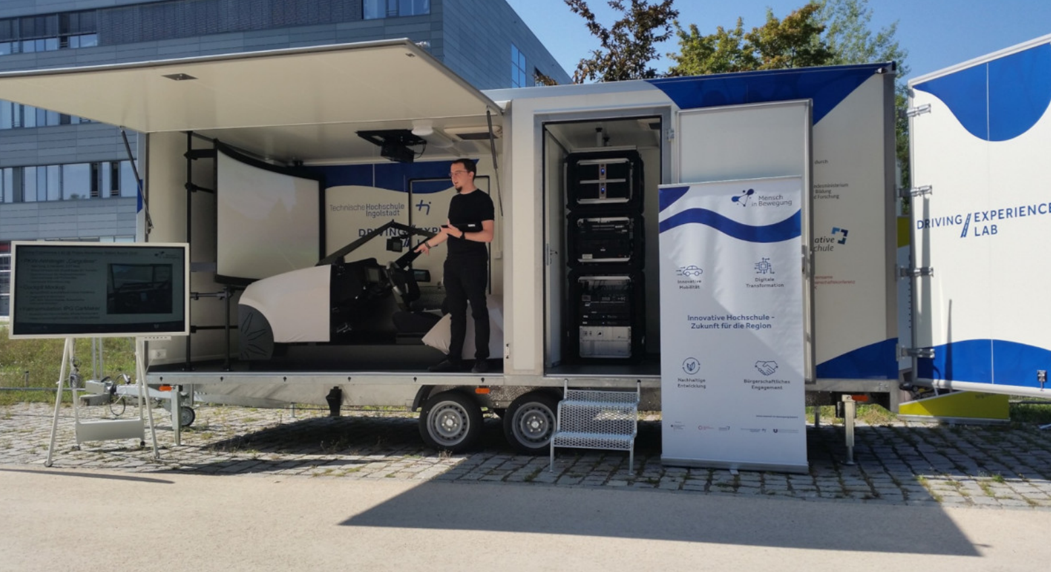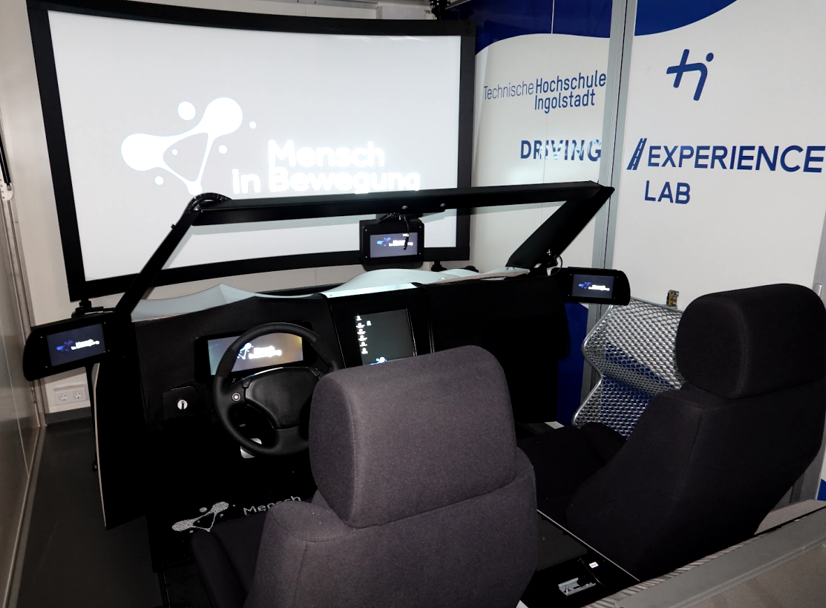Driving Experience Lab

In our joint project Mensch in Bewegung of the Technical University of Ingolstadt (THI) and the Catholic University of Eichstätt-Ingolstadt (KU), the Driving Experience Lab (DEL) was developed. The passenger-car trailer features a driving simulator lab that can be moved anywhere by land and aims to generate information about automated driving.
In addition to mobile operations, the DEL also serves as a supplement for the execution of student research projects and theses at the
Technical University of Ingolstadt. Especially in the context of master theses and project work, research goals can be validated here. The laboratory is also available for service partners in the context of third-party funding by industry.
Advantages of the DEL setup:
- Provision of a mobile platform for informing a broad public about current research topics
- Knowledge transfer in the field of automated driving
- Final theses through studies in the trailer on HCI and HF
- Third-party contracts through the industry
Built-in technology
By embedding a wide variety of components (tactile driver’s seat, vibration steering wheel, windshield display) into the mobile driving simulator, a highly immersive (real) driving experience can be achieved. The DEL consists of a “driving simulator room” with mockup and flap and a “control room” with a server rack in the back. Inside the mockup, subjects can experience a virtual drive in the driving simulator, controlled by the operator’s room. The operator room contains the computing infrastructure (server rack), a 3-monitor workstation, and cabinets for storage. The following figure gives an overview of the main areas of the DEL.

Mockup
The equipment used is modular and can be expanded. In the mockup, the equipment for the steering wheel, pedals via Arduino microcontroller, and displays via different interfaces, e.g. the Senso-Wheel via CAN2USB are integrated. The driving simulations are created and operated via IPG CarMaker and a specially created middleware.
Currently, the following devices are in use:
- Active Senso-Wheel force feedback steering wheel
- Digital displays for rearview mirrors
- Visualization and Simulation PC
- NAS, UPS, and Sound-AMPs
- Arduino-Microcontroller
- Windshield display with Intel® NUC Mini-PC

Extension
To further increase the immersion of the Driving Experience Lab in the future, the following further developments are planned and partly already being implemented (Figure 3):
- Increased use of vibration feedback in the steering wheel and driver’s seat, e.g. to announce obstacles
- Dynamic (ambient) interior lighting, e.g. for simulating tunnel driving or backlighting
- Greater use of vibration feedback in the steering wheel and driver’s seat, e.g. to announce obstacles
- Analysis of driver behavior through facial recognition, drowsiness detection, and eye-tracking and influencing of adaptive systems
- Extension of the scenarios for the SAE automation levels 1 to 5 (e.g. influence by other road users including pedestrians) or integration of weather effects and road conditions (day, night, snow, rain, fog)
- High-fidelity implementation of ambient noise (e.g., applied audio signal with convolution reverberation, Doppler effect, and frequency shift during tunnel ride)

Possible scenarios in our DEL
Our mobile driving simulator gives you the opportunity to experience levels 2 to 5 of automated driving. The following scenarios await you in our driving simulator:
All journeys start at the hard shoulder in the city center. In levels 2 and 3, you maneuver the vehicle onto the motorway yourself and here you can activate the automation. In level 4 the automation can be turned on at the beginning of the ride and in level 5 you become a passenger from the start.
Today: Your journey is supported by the driver assistance systems at level 2. Using the adaptive cruise control and coupling them with the automatic lateral guidance, you can delegate steering control to the vehicle. However, you have to recognize potential dangers and issues on the road and problems yourself.
Tomorrow: In level 3, the vehicle can drive independently on the freeway. You can use your time to work, read or make phone calls. At a construction site, the vehicle will ask you to take over the steering (TOR – Take Over Request). You steer the vehicle through the construction site and then hand over the control again.
The day after tomorrow: You set off from the city center in a level 4-capable vehicle. If the automation is activated, you can sleep while driving or deal with tasks such as reading, watching a film, or working. If a problem arises while driving and the vehicle does not know what to do, it will bring itself to a safe state. It pulls onto the hard shoulder and stops.
Future: The ultimate goal, fully automated driving at level 5, is still a long way off. You will be picked up by a fully automated vehicle without a steering wheel or pedals and dropped off at the desired location.
The Driving Experience Lab (360° walkthrough)
